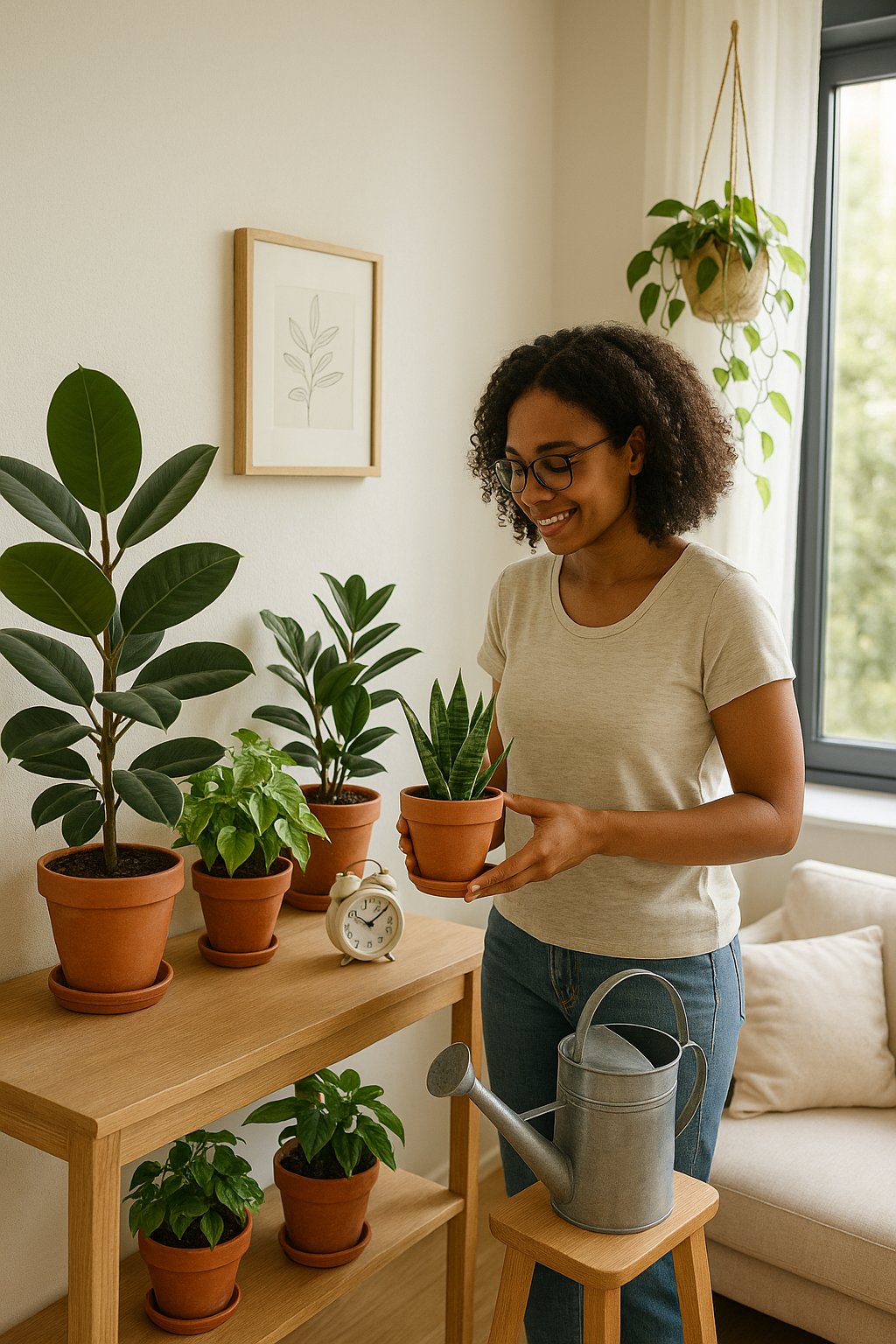Caring for plants brings joy, relaxation, and beauty to any living space—but if you live a fast-paced life, it can feel like just another task on your to-do list. The good news is: apartment gardening doesn’t have to be time-consuming or stressful. With the right routine, tools, and plant choices, you can enjoy the benefits of greenery without needing to be a full-time plant parent.
This article outlines how to build a low-maintenance plant care routine that fits your lifestyle—even if you’re always on the go.
Choose the Right Plants
The first step in creating a low-maintenance routine is selecting plants that naturally require less care. Some plants are more forgiving when it comes to watering, light fluctuations, and neglect.
Top Low-Maintenance Indoor Plants
- Snake Plant (Sansevieria) – Extremely drought-tolerant and tolerates low light.
- ZZ Plant (Zamioculcas zamiifolia) – Hardy, thrives in low light, and needs watering only every couple of weeks.
- Pothos – Grows quickly, tolerates low to medium light, and recovers well from underwatering.
- Spider Plant – Easy to grow, adaptable, and pet-friendly.
- Peace Lily – Thrives in low light and indicates when it needs water by drooping.
- Aloe Vera – A succulent that loves sun and doesn’t mind if you forget to water it.
Choosing low-maintenance plants sets the foundation for a routine that won’t overwhelm you.
Keep a Minimal, Focused Collection
It’s tempting to fill every shelf and windowsill with greenery—but more plants mean more responsibility. Focus on quality over quantity. Start with a manageable number of plants (3–5) and add more only if you feel comfortable maintaining them.
Grouping your plants also makes care easier. Watering, cleaning, and monitoring becomes a quick, efficient task rather than a scattered one.
Create a Simple Watering Schedule
Inconsistent watering is the most common plant care mistake, especially among busy individuals. To prevent overwatering or underwatering, create a recurring routine:
Watering Tips:
- Use a calendar or reminder app: Set weekly or biweekly reminders based on each plant’s needs.
- Check soil moisture: Stick your finger 1–2 inches into the soil. If it feels dry, it’s time to water.
- Use self-watering pots: These are perfect for plants that require consistent moisture without daily attention.
- Water in the morning: This allows plants to absorb moisture before the sun evaporates it and reduces the risk of fungus.
Once you establish a rhythm, watering becomes a 10-minute weekly habit.
Place Plants Strategically
Placing your plants in the right location reduces the need for constant adjustments.
- Bright, indirect light: Most houseplants thrive here. Place them near a north- or east-facing window.
- Avoid drafts and radiators: Sudden temperature changes stress plants.
- Rotate occasionally: Turning your plants every couple of weeks ensures even growth and exposure.
Choosing the right spot can minimize stress and keep plants healthy with less effort.
Group Plants with Similar Needs
Another time-saving tip is to group plants with similar light and water requirements. For example, keep your succulents together in a sunny spot and your tropical, shade-loving plants in another. This way, you can water and care for each group in one go.
Keep Tools and Supplies Handy
Make your routine effortless by having a small plant care kit nearby. Include:
- A small watering can
- Moisture meter (optional but helpful)
- Pruning scissors
- Fertilizer sticks or liquid feed
- Soft cloth for wiping leaves
- Extra pots or trays for repotting
Store everything in one place, like a decorative basket or a small shelf near your plants, so you don’t waste time searching when it’s time to care for them.
Use Slow-Release Fertilizers
Instead of remembering to fertilize your plants every two weeks, opt for slow-release fertilizer pellets or sticks. These gradually feed your plants over several months with minimal intervention. This approach is perfect for busy people who still want their plants to thrive and grow.
Dust and Prune Occasionally
Dust buildup can block sunlight and reduce photosynthesis. Make it a monthly habit to gently wipe leaves with a damp cloth. At the same time, prune any dead or yellowing leaves to keep your plant healthy and attractive.
This routine only takes about 15 minutes a month and keeps your plants vibrant and resilient.
Consider Self-Watering and Automated Systems
If you want to make plant care almost effortless, technology can help:
- Self-watering pots maintain consistent soil moisture.
- Watering globes slowly release water into the soil.
- Automatic drip irrigation kits can be set up for balconies or larger collections.
- Plant care apps track watering, fertilizing, and even sunlight needs.
These tools are especially useful if you travel frequently or work long hours.
Know When to Say Goodbye
Not every plant will thrive in your environment or fit your schedule. If a plant is consistently struggling and causing you stress, don’t feel guilty about replacing it with a more suitable variety. Your apartment garden should be a source of joy—not frustration.
Final Thought: Green Living Without the Stress
A thriving apartment garden doesn’t require hours of labor or constant monitoring. By selecting low-maintenance plants, establishing a simple care routine, and using smart tools, you can enjoy all the benefits of indoor greenery—even with a busy lifestyle.
Consistency, even in small efforts, goes a long way. Once your routine is in place, your plants will quietly grow and beautify your home—no stress, no fuss, just calm, living decor.
